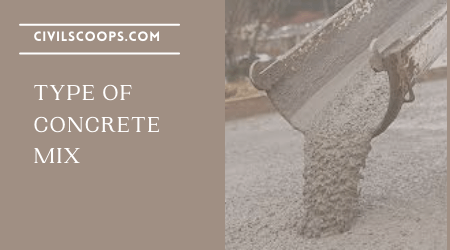What Is Grade of Concrete | Concrete Mix Ratio | Type of Concrete Mix | Different Types of Concrete Grade with Concrete Mix Ratio and Compressive Strength | Uses of Different Grades of Concrete
Table of Contents
What Is Grade of Concrete
- By the composition and strength of the concrete, the grades of concrete are defining.
- For the initial construction, the minimum strength of concrete should have followed at 28 days.
- The grade of concrete is expressed in the measurement MPa. Where the M is stand for mix and the MPa expressed the overall strength of the concrete.
- As an example for the M20 grade of concrete, Where the M stands for mix and 20 means the maximum compressive strength achieves by the concrete 20N/mm2 at 28 days.
- The size of the cube upon which the compressive strength test is done is 150 X 150 X 150 mm.
The Different Types Grade of Concrete Is Below
[su_table responsive=”yes” alternate=”yes” fixed=”no”]
| GROUP | DESIGNATION | CHARACTERISTIC COMPRESSIVE STRENGTH Fck AT 28 DAYS |
| ORDINARY CONCRETE | M 10 | 10 |
| M 15 | 15 | |
| M 20 | 20 | |
| M 25 | 25 | |
| M30 | 30 | |
| M35 | 35 | |
| STANDARD CONCRETE | M 40 | 40 |
| M 45 | 45 | |
| M 50 | 50 | |
| M 55 | 55 | |
| M 60 | 60 | |
| M 65 | 65 | |
| HIGH STRENGTH CONCRETE | M 70 | 70 |
| M 75 | 75 | |
| M 80 | 80 |
[/su_table]
Concrete Mix Ratio
The different grade of concrete and with the required grade in the constructions, the concrete mix ratio is different that’s are below-
Grade of Concrete
- For the M5 grade of concrete the mix ratio (cement: sand: aggregate) is 1: 5: 10 and the compressive strength 5 MPa ( N/mm2 ) or 725 psi.
- For the M7.5 grade of concrete the mix ratio (cement: sand: aggregate) is 1: 4: 8 and the compressive strength 7.5 MPa ( N/mm2 ) or 1087 psi.
- And for the M10 grade of concrete the mix ratio (cement: sand: aggregate) is 1 : 3: 6 and the compressive strength 10 MPa ( N/mm2 ) or 1450 psi.
- For the M15 grade of concrete the mix ratio (cement: sand: aggregate) is 1 : 2: 4 and the compressive strength 15 MPa ( N/mm2 ) or 2175 psi.
- For the M20 grade of concrete the mix ratio (cement: sand: aggregate) is 1: 1.5 : 3 and the compressive strength 20 MPa ( N/mm2 ) or 2900 psi.
The Standard Grade of Concrete
The Standard grade of concrete is below-
- For the M25 grade of concrete the mix ratio (cement: sand: aggregate) is 1 : 1: 2 and the compressive strength 25 MPa ( N/mm2 ) or 3625 psi.
- For the M30 grade of concrete the mix ratio (cement : sand: aggregate) is the design mix and the compressive strength 30 MPa ( N/mm2 ) or 4350 psi.
- And for the M35 grade of concrete the mix ratio (cement: sand: aggregate) is the design mix and the compressive strength 35 MPa ( N/mm2 ) or 5075 psi.
- For the M40 grade of concrete the mix ratio (cement: sand: aggregate) is the design mix and the compressive strength 40 MPa ( N/mm2 ) or 5800 psi.
- For the M45 grade of concrete the mix ratio (cement : sand: aggregate) is the design mix and the compressive strength 45 MPa ( N/mm2 ) or 6525 psi.
High Strength Grade of Concrete-
The high strength grade of concrete is below-
- For the M50 grade of concrete the mix ratio (cement: sand: aggregate) is the design mix and the compressive strength 50 MPa ( N/mm2 ) or 7250 psi.
- For the M55 grade of concrete the mix ratio (cement: sand: aggregate) is the design mix and the compressive strength 55 MPa ( N/mm2 ) or 7975 psi.
- And for the M60 grade of concrete the mix ratio (cement: sand: aggregate) is the design mix and the compressive strength 60 MPa ( N/mm2 ) or 8700 psi.
- For the M65 grade of concrete the mix ratio (cement: sand: aggregate) is the design mix and the compressive strength 65 MPa ( N/mm2 ) or 9425 psi.
- For the M70 grade of concrete the mix ratio (cement : sand: aggregate) is the design mix and the compressive strength 70 MPa ( N/mm2 ) or 10150 psi.
Also Read: What Is Lintel? | Function of Lintel | Types of Lintel
Type of Concrete Mix

Genarally there are two types of concrete mix that’s are below-
Nominal Mix
In which mix the below-grade of concrete are used that’s that is called nominal mix. The grads are-
- M5 grade and the ratio is 1: 5: 10.
- M7.5 grade and the ratio is 1 : 4: 8.
- M10 grade and the ratio is 1 : 3: 6.
- M15 grade and the ratio is 1 : 2: 4.
- M20 grade and the ratio is 1: 1.5 : 3.
Design Mix
In which mix M25, M30, M35, M40, M45, M50, M55, M60, M65, and M70 grade of concrete are used that’s is called design mix.
Different Types of Concrete Grade with Concrete Mix Ratio and Compressive Strength
Normal Concrete Grade
- For the M5 grade of concrete the mix ratio (cement : sand : aggregate) is 1 : 5 : 10 and the compressive strength 5 MPa ( N/mm2 ) or 725 psi.
- For the M7.5 grade of concrete the mix ratio (cement : sand : aggregate) is 1 : 4 : 8 and the compressive strength 7.5 MPa ( N/mm2 ) or 1087 psi.
- And for the M10 grade of concrete the mix ratio (cement : sand : aggregate) is 1 : 3 : 6 and the compressive strength 10 MPa ( N/mm2 ) or 1450 psi.
- For the M15 grade of concrete the mix ratio (cement : sand : aggregate) is 1 : 2 : 4 and the compressive strength 15 MPa ( N/mm2 ) or 2175 psi.
- For the M20 grade of concrete the mix ratio (cement : sand : aggregate) is 1 : 1.5 : 3 and the compressive strength 20 MPa ( N/mm2 ) or 2900 psi.
Standard Concrete Grade
- For the M25 grade of concrete the mix ratio (cement : sand : aggregate) is 1 : 1 : 2 and the compressive strength 25 MPa ( N/mm2 ) or 3625 psi.
- For the M30 grade of concrete the mix ratio (cement : sand : aggregate) is design mix and the compressive strength 30 MPa ( N/mm2 ) or 4350 psi.
- And for the M35 grade of concrete the mix ratio (cement : sand : aggregate) is design mix and the compressive strength 35 MPa ( N/mm2 ) or 5075 psi.
- For the M40 grade of concrete the mix ratio (cement : sand : aggregate) is design mix and the compressive strength 40 MPa ( N/mm2 ) or 5800 psi.
- For the M45 grade of concrete the mix ratio (cement : sand : aggregate) is design mix and the compressive strength 45 MPa ( N/mm2 ) or 6525 psi.
High Strength Concrete Grade
- For the M50 grade of concrete the mix ratio (cement : sand : aggregate) is design mix and the compressive strength 50 MPa ( N/mm2 ) or 7250 psi.
- For the M55 grade of concrete the mix ratio (cement : sand : aggregate) is design mix and the compressive strength 55 MPa ( N/mm2 ) or 7975 psi.
- And for the M60 grade of concrete the mix ratio (cement : sand : aggregate) is design mix and the compressive strength 60 MPa ( N/mm2 ) or 8700 psi.
- For the M65 grade of concrete the mix ratio (cement : sand : aggregate) is design mix and the compressive strength 65 MPa ( N/mm2 ) or 9425 psi.
- For the M70 grade of concrete the mix ratio (cement : sand : aggregate) is design mix and the compressive strength 70 MPa ( N/mm2 ) or 10150 psi.
Uses of Different Grades of Concrete
The many uses of different grade of concrete is below-
Normal Grade of Concrete
- In the normal grade of concrete M5, M10, M15 are generally used plain cement concrete (PCC) work for bedding for footing or leveling courses, etc.
- The M20 grade of concrete is used for reinforcement cement concrete (RCC) work such as column, beam, slab, and footing, etc.
The Standard Grade of Concrete
- The M25, M30, M35 grades are used for reinforcement cement concrete (RCC) as footing columns, slabs, beams, foundations, etc.
- For the pre-stressed concrete work, M4O grade is used for beams, slabs, columns, footing, etc.
- For the pre-stressed concrete girder, runway, concrete roads pre-stressed beams, RCC columns M45, and M50 are used.
- For the piers and pre-stressed concrete girder, the M55 grade of concrete is used.
High Strength Concrete
- Where the high compressive strength is required such as long-span bridge, high rise building, ultra-thin white topping, coastal construction, spillways of dams, etc. there we used M60, M65, and M70 grade of concrete are used.
[note note_color=”#F2F2F2 ” text_color=”#333333″ radius=”3″ class=”” id=””]
Like this post? Share it with your friends!
Suggested Read –
- What Is Gable Roof | History of Gable Roofing | Gable Roof Design | Parts of Gable Roof | Types of Gable Roofs | How Long Can the Roof Last? | Gable Roof Advantages and Disadvantages | Cost of Gable Roof Construction |
- Building Layout | How to Building Layout | Construction Layout Techniques
- How a Building Is Constructed | Components of Building
- What Is Bituminous Road? | Bituminous Road Construction | Bituminous Road Layers | Bituminous Macadam | Bituminous Road Construction Process | Advantages of Bitumen Road | Disadvantages of Bitumen Road | Application Road
- What Is Super Elevation? | Superelevation Definition | Purpose of Providing Superelevation in Roads | Calculation of Superelevation in Roads | Minimum and Maximum Superelevation in Roads | Method of Providing Superelevation to the Roads
[/note]
Originally posted 2021-07-14 16:35:33.

